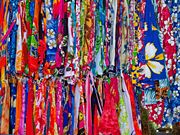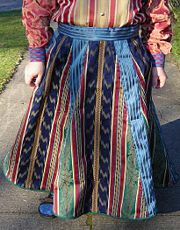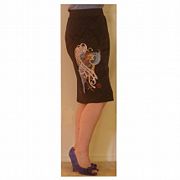Skirt

A skirt is a tube- or cone-shaped garment that hangs from the waist and covers all or part of the legs.
In European culture, skirts are usually considered women's clothing. However, there are exceptions. The kilt is a traditional men's garment in Scotland, and some fashion designers, such as Jean-Paul Gaultier, have shown men's skirts.
At its simplest, a skirt can be a draped garment made out of a single piece of material (such as pareos), but most skirts are fitted to the body at the waist and fuller below, with the fullness introduced by means of dart, gores, pleats, or panels. Modern skirts are usually made of light to mid-weight fabrics, such as denim, jersey, worsted, or poplin. Skirts of thin or clingy fabrics are often worn with slips to make the material of the skirt drape better and for modesty.
The hemline of skirts can be as high as the upper thigh or as low as the ground, depending on the whims of fashion and the modesty or personal taste of the wearer.
Some medieval upper-class women wore skirts over 3 metres in diameter at the bottom. At the other extreme, the miniskirts of the 1960s were minimal garments that may have barely covered the underwear when seated.
Costume historians typically use the word "petticoat" to describe skirt-like garments of the 18th century or earlier.
Contents[hide] |
History
Skirts have been worn by men and women from many cultures, such as the lungi, kanga and sarong worn in South Asia and Southeast Asia, and the kilt worn in Scotland.
The earliest known culture to have females wear miniskirts were the Duan Qun Miao, which literally meant "short skirt Miao" in Chinese. This was in reference to the short miniskirts "that barely cover the buttocks" worn by women of the tribe, and which were "probably shocking" to Han Chinese observers in medieval and early modern times.[1]
Skirts in the 19th century
During the nineteenth century, the cut of women's dresses in western culture varied more widely than in any other century. Waistlines started just below the bust (the Empire silhouette) and gradually sank to the natural waist. Skirts started fairly narrow and increased dramatically to the hoopskirt and crinoline-supported styles of the 1860s; then fullness was draped and drawn to the back by means of bustles.
- See also History of Western fashion: 1795-1820, 1820s, 1830s, 1840s,1850s, 1860s, 1870s, 1880s, 1890s
- Victorian fashion, Artistic Dress movement, Victorian dress reform.

Skirts in the 20th and 21st centuries
Beginning around 1915, hemlines for daytime dresses left the floor for good. For the next fifty years, fashionable skirts became short (1920s), then long (1930s), then shorter (the War Years with their restrictions on fabric), then long (the New Look), then shortest of all during the 1960s, when skirts became as short as possible while avoiding exposure of underwear, which was considered taboo.
Since the 1970s and the rise of pants for women as an option for all but the most formal of occasions, no one skirt length has dominated fashion for long, with short and ankle-length styles often appearing side-by-side in fashion magazines and catalogs.

Basic types
- Straight skirt, a tailored skirt hanging straight from the hips and fitted from the waist to the hips by means of darts or a yoke; may have a kick-pleat for ease of walking
- Full skirt, a skirt with fullness gathered into the waistband
- A-line skirt, a skirt with a slight flare, roughly in the shape of a capital letter A
- Pleated skirt, a skirt with fullness reduced to fit the waist by means of regular pleats ('plaits') or folds, which can be stitched flat to hip-level or free-hanging
- Circle skirt, a skirt cut in sections to make one or more circles with a hole for the waist, so the skirt is very full but hangs smoothly from the waist without darts, pleats, or gathers
- Hobble skirt, long and tight skirt with a narrow enough hem to significantly impede the wearer's stride
Fads and fashions
- Ballerina skirt, a full-length formal skirt popular in the 1950s.
- Broomstick skirt, a skirt with many crumpled pleats formed by compressing and twisting the garment while wet (1980s and on)
- Cargo skirt, a plain, utilitarian skirt with belt loops and numerous large pockets, based on the military style of Cargo pants and popularised in the 1990s.
- Dirndl, a skirt made of a straight length of fabric gathered at the waist
- Jean skirt, A trouser skirt made of denim, often designed like 5-pocket jeans, but found in a large variety of styles.
- Leather skirt, A skirt made of leather
- Kilt-skirt, a wrap-around skirt with overlapping aprons in front and pleated around the back. Though traditionally designed as women's wear, it is fashioned to mimic somewhat closely the general appearance of a (man's) kilt, including the usage of a plaid pattern more or less closely resembling those of recognized tartan patterns of Scotland.

- Maxiskirt, an ankle length-skirt (1970s, but has made a comeback in the 2000s)
- Midi skirt, mid-calf length. See: 1970s in fashion.
- Miniskirt, a thigh-length skirt, and micromini, an extremely short version (1960s)
- Poodle skirt, a circle or near-circle skirt with an appliqued poodle or other decoration (1950s)
- Prairie skirt, a flared skirt with one or more flounces or tiers (1970s and on)
- Rah-rah skirt, a short, tiered, and often colourful skirt fashionable in the early-mid 1980s.
- Sarong, a square of fabric wrapped around the body and tied on one hip to make a skirt; worn as a skirt or as a cover-up over a bathing suit in tropical climates.
- Tiered skirt, made of several horizontal layers, each wider than the one above, and divided by stitching. Layers may look identical in solid-colored garments, or may differ when made of printed fabrics.
- Trouser skirt, a straight skirt with the part above the hips tailored like men's trousers, with belt loops, pockets, and fly front
- T-skirt, made from a T-shirt, the T-skirt is generally modified to result in a pencil skirt, with invisible zippers, full length 2-way separating side zippers, as well as artful fabric overlays and yokes.
Male wear
There are a number of male garments which fall under the catergory of "skirt" or "dress." These go by a variety of names and form part of the traditional dress for men from various cultures. Usage varies - the dhoti is part of everyday dress on the Indian subcontinent while the kilt is more usually restricted to occasional wear and the foustanella is used almost exclusively as costume. Robes, which are a type of dress for men, have existed in many cultures, including the Japanese kimono, the Chinese cheongsam, the Arabic thobe, and the African Senegalese kaftan. Robes are also used in some religious orders, such as the cassock in Christianity and various robes and cloaks that may be used in pagan rituals. Examples of men's skirts and skirt-like garments from various cultures include:
- The kilt is not a skirt but an historic Gaelic and Celtic garment, part of the Scottish national dress in particular, and is worn formally and to a lesser extent informally. Irish and Welsh kilts also exist but are not so much a part of national identity.
- The foustanella is worn by men in Greece and other parts of the Balkans. By the mid-20th Century, it was relegated to ceremonial use and as period or traditional costume.
- The gho is a knee-length robe worn by men in Bhutan. They are required to wear it every day as part of national dress.
- The sarong is a piece of cloth that may be wrapped around the waist to form a skirt-like garment. Sarongs exist in various cultures under various names, including the pareo and lavalava of the Hawaiian islands, the Indian dhoti and lungi, and the South Indian mundu.
In the Western world skirts, dresses and similar garments are considered primarily women's clothing today although historically that was not the case.[2] The wearing of skirts by men in these areas is generally seen as cross-dressing although some fashion designers such as Jean-Paul Gaultier have produced skirts for men and kilts are widely accepted in some situations.
In various subcultures, such as the goth and punk subcultures, the use of skirts by men is not necessarily seen as cross-dressing and is much more likely to be accepted.
See also
- 1970s in fashion
- Blouse
- Clothing terminology
- Dress
- Women wearing pants
References
- ↑ Harrell, Stevan (1995), Cultural Encounters on China's Ethnic Frontiers, University of Washington Press, pp. 98 & 103, ISBN 0295975288
- ↑ A closer look at men in skirts, CNN, November 3 2003. Retrieved March 17 2008.
- Oxford English Dictionary
- Brockmamn, Helen L.: The Theory of Fashion Design, Wiley, 1965.
- Picken, Mary Brooks: The Fashion Dictionary, Funk and Wagnalls, 1957. (1973 edition ISBN 0-308-10052-2)
- Tozer, Jane, and Sarah Levitt: Fabric of Society: A Century of People and Their Clothes 1770-1870, Laura Ashley Ltd., 1983; ISBN 0-9508913-0-4
External links
- Stylopedia -- an online dictionary of fashion details
- ApparelSeach glossary of textile and apparel terms
- An international dress size converter
- Wholesale Clothing Blog
|
||||||||||||||||||||||||||||||||||||||||||||||||||